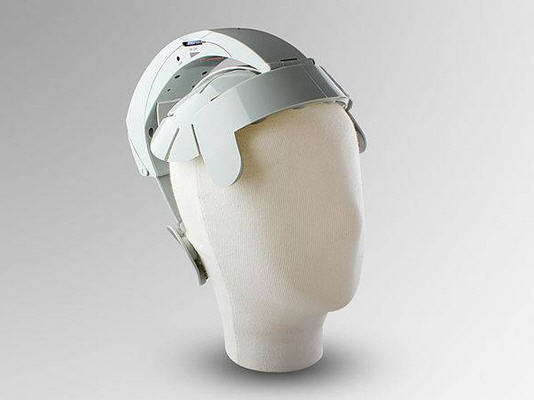Nexcopy Introduces USB Flash Drive Printer

UPDATE: The Nexcopy USB flash drive printer has been upgraded to a 40-up full-color print unit. Nexcopy has replaced the USB7P printer with the new LOGO-EZ PRINTER. This updated model includes a custom-built tray designed to securely hold USB drives in place during high-speed printing. Pricing starts at approximately $3,500.
Press Release: Nexcopy Launches USB Flash Drive Printer
Lake Forest, CA – June 11, 2014 – Nexcopy Inc. has announced the release of its full-color USB flash drive printer. This new inkjet printer is designed to print vivid, high-resolution logos directly onto USB swivel clips. Targeted at small businesses, marketing firms, and promotional companies, the printer is ideal for fast, in-house branding and short production runs.
Fast and Efficient Printing with the USB7P
Using Nexcopy’s seven-slot USB flash drive printer and specially coated printable clips, users can easily print high-quality images in under 35 seconds.
- Supports standard JPEG and BMP image formats
- Prints 7 identical or 7 unique logos per batch
- Dual-sided printable swivel USB clips
- White matte finish ideal for color accuracy
- Perfect for single samples or small-to-medium print jobs
- Printed images are dry instantly, water-resistant, and scratch-resistant
- Compatible with most standard swivel USB flash drive designs
Affordable In-House USB Printing
“The USB flash drive printer is a major innovation for Nexcopy,” said Greg Morris, President of Nexcopy Inc. “The USB7P provides a cost-effective way for marketing and promotional companies to produce vibrant, branded USB flash drives in-house, without the delays or expenses of outsourcing.”
HP Inkjet Technology for Vibrant Results
The USB7P is powered by Hewlett Packard’s reliable inkjet technology, known for precise color reproduction and Pantone color matching. In testing, the printer produced seven full-color clips in 35 seconds. Black-only logo printing can be completed in as little as 15 seconds.
Lower Cost, Faster Turnaround
“With our USB flash drive printer, small businesses can save on shipping, screen setup fees, and costly print runs,” added Morris. “Some of our resellers simply grabbed logos from a customer’s website, printed them directly on USB clips, and landed bulk orders the next day. That’s the power of fast, on-demand branding.”
USB7P Specifications
The printer weighs 11 lbs (5 kg) and has dimensions of 18 x 11.5 x 10.5 inches (452 x 286 x 267 mm). It ships with universal power support (110V/220V), includes one CMY cartridge, one black cartridge, and 20 printable clips. The tray holds 7 clips per print cycle. MSRP: $1,799. “USB Flash Drive Printer” is a trademark of Nexcopy Inc.
Product Resources
Global Reseller Network
Nexcopy’s full line of duplication systems—including USB, CF, SD, and microSD duplicators—is available through a global network of authorized resellers.
About Nexcopy Incorporated
Nexcopy specializes in developing and manufacturing advanced flash memory duplication systems. As a pioneer in the solid-state memory sector, Nexcopy services markets in North America, Europe, India, Asia, and the Pacific Rim, with U.S. headquarters located at 13 Orchard Road, Suite 102, Lake Forest, CA 92630.
Nexcopy Incorporated
Mr. Greg Morris
+1 949 481 6478
contact@nexcopy.com
https://www.nexcopy.com



 Well, it seems that entrepreneur Jonty Lovell has done something about it as the all new – and fully funded – Password Reset Key has been designed to take the hassle out of this common issue. In fact, as long as you have physical access to the system even home owners can now reset their forgotten password within mere moments.
The secret to the Password Reset Key is the fact that it combines a key shaped 1GB flash drive – available in black, stainless steel, or ‘gold’ – with a simple OS that auto-loads his custom software upon startup. Just as with L0phtcrack, with a simple click or three, you can scan, reset and even test how secure a given systems login passwords are. Because of its ‘key’ form factor, it will be hard to lose as you can simply stick on your keychain and always have it close at hand. However, be warned that this $15 – $50 device (depending on which option to choose) may get you in trouble with your IT staff as resetting the ‘administrator’ password will greatly ‘annoy’ them if they find out.
Well, it seems that entrepreneur Jonty Lovell has done something about it as the all new – and fully funded – Password Reset Key has been designed to take the hassle out of this common issue. In fact, as long as you have physical access to the system even home owners can now reset their forgotten password within mere moments.
The secret to the Password Reset Key is the fact that it combines a key shaped 1GB flash drive – available in black, stainless steel, or ‘gold’ – with a simple OS that auto-loads his custom software upon startup. Just as with L0phtcrack, with a simple click or three, you can scan, reset and even test how secure a given systems login passwords are. Because of its ‘key’ form factor, it will be hard to lose as you can simply stick on your keychain and always have it close at hand. However, be warned that this $15 – $50 device (depending on which option to choose) may get you in trouble with your IT staff as resetting the ‘administrator’ password will greatly ‘annoy’ them if they find out.
 If anyone ends up buying this USB head massager, please post a picture of you wearing it on our
If anyone ends up buying this USB head massager, please post a picture of you wearing it on our 
 From the notes in the document, these designs could change, but at least we have an idea.
From the notes in the document, these designs could change, but at least we have an idea.
 Alaska Airlines passengers will now be able to use their tablets, book readers, and cellphones all the way from the gate to thousands of feet in the air.
Starting Nov. 9, passengers will be able to use their electronic devices on board the plane, and even use WiFi, at 10,000 feet in the air. Alaska Airlines will start flying its first aircraft with 110-volt and
Alaska Airlines passengers will now be able to use their tablets, book readers, and cellphones all the way from the gate to thousands of feet in the air.
Starting Nov. 9, passengers will be able to use their electronic devices on board the plane, and even use WiFi, at 10,000 feet in the air. Alaska Airlines will start flying its first aircraft with 110-volt and 
 Revi Charger is a creative form factor. The Revi power station is a cordless device which will accommodate either USB or microUSB sockets.
The Revi was designed to be sleak and stylish charging unit and is available in 550mAh capacity or 1440 mAh capacity. Retailing for $25 and $35 respectively
“Since we are already funded, we were able to gather the world’s top talent to produce the Revi Charger. We want our customers to receive the biggest boost when they need it the most with no wires.”
The company also has one impressive website that is easy to navigate, gather information and order.
Revi Charger is a creative form factor. The Revi power station is a cordless device which will accommodate either USB or microUSB sockets.
The Revi was designed to be sleak and stylish charging unit and is available in 550mAh capacity or 1440 mAh capacity. Retailing for $25 and $35 respectively
“Since we are already funded, we were able to gather the world’s top talent to produce the Revi Charger. We want our customers to receive the biggest boost when they need it the most with no wires.”
The company also has one impressive website that is easy to navigate, gather information and order.


 The Corsair Voyager Go USB is available as a 3.0 device in 16, 32 and 64GB capacity. USB 3.0 can boost transfer speeds in excess of 135MB/s however we must realize this spec is not real-world environment.
The Corsair Voyager Go USB is available as a 3.0 device in 16, 32 and 64GB capacity. USB 3.0 can boost transfer speeds in excess of 135MB/s however we must realize this spec is not real-world environment.
 Source:Â Corsair, CES.
Source:Â Corsair, CES.

 The company has just released it’s latest pen scanner, the ScanStik SK600V. The V is for Voice Notes. It’s now possible to scan from a device the size of a writing pen and include voice memos for the scanned document. Nice.
They have also added bluetooth connectivity, but apparently the “b” didn’t make it into the updated part number.
You can scan at 600dpi (dots per inch) and save the file to a microSD card. Once you are ready for download, you can connect to a host computer via USB and off-load all those trade show business cards (or competitors spec sheets of that product not yet released).
The company has just released it’s latest pen scanner, the ScanStik SK600V. The V is for Voice Notes. It’s now possible to scan from a device the size of a writing pen and include voice memos for the scanned document. Nice.
They have also added bluetooth connectivity, but apparently the “b” didn’t make it into the updated part number.
You can scan at 600dpi (dots per inch) and save the file to a microSD card. Once you are ready for download, you can connect to a host computer via USB and off-load all those trade show business cards (or competitors spec sheets of that product not yet released).